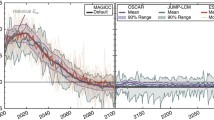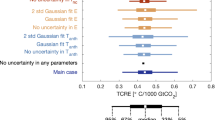Abstract
Representative Concentration Pathway 6.0 (RCP6) is a pathway that describes trends in long-term, global emissions of greenhouse gases (GHGs), short-lived species, and land-use/land-cover change leading to a stabilisation of radiative forcing at 6.0 Watts per square meter (Wm−2) in the year 2100 without exceeding that value in prior years. Simulated with the Asia-Pacific Integrated Model (AIM), GHG emissions of RCP6 peak around 2060 and then decline through the rest of the century. The energy intensity improvement rates changes from 0.9% per year to 1.5% per year around 2060. Emissions are assumed to be reduced cost-effectively in any period through a global market for emissions permits. The exchange of CO2 between the atmosphere and terrestrial ecosystem through photosynthesis and respiration are estimated with the ecosystem model. The regional emissions, except CO2 and N2O, are downscaled to facilitate transfer to climate models.













Similar content being viewed by others
Notes
Climate sensitivity is the number of degrees that the global average temperature could be expected to rise, relative to pre-industrial climate, if the concentration of CO2 were to double and remain at that level indefinitely.
References
Dimaranan BV (Ed) (2006) Global trade, assistance, and production: the GTAP 6 data base. Center for Global Trade Analysis, Purdue University
D. P. van Vuuren, J. Edmonds, M. Kainuma, K. Riahi, A. Thomson, K. Hibbard, G.C. Hurtt, T. Kram, V. Krey, J-F Lamarque, T. Matsui, M. Meinshausen, N. Nakicenovic, S. J. Smith and S. K. Rose (2011). The representative concentration pathways: an overview. Climatic Change. This issue. doi:10.1007/s10584-011-0148-z
Grubler A, O’Neill B, Riahi K, Chirkov V, Goujon A, Kolp P, Prommer I, Scherbov S, Slentoe E (2007) Regional, national, and spatially explicit scenarios of demographic and economic change based on SRES. Technol Forecast Soc Chang 74:980–1029
Hijioka Y et al (2008) Global GHG emission scenarios under GHG concentration stabilization targets. J Glob Environ Eng 13:97–108
Hoelzemann J et al (2004) Global Wildland Fire Emission Model (GWEM): evaluating the use of global area burnt satellite data. J Geophys Res 109. doi:10.1029/2003JD003666
Houghton et al (1983) Changes in the carbon content of terrestrial biota and soils between 1860 and 1980: A net release of CO2 to the atmosphere. Ecol Monogr 53:235–262
Hurtt G et al (2011) Land use change and earth system dynamics. Clim Chang this volume
International Energy Agency (2007a) Energy balances of OECD countries (2007 Edition), IEA
International Energy Agency (2007b) Energy balances of Non-OECD countries (2007 Edition), IEA
International Energy Agency (2008) World energy outlook 2008, IEA
Ito A (2005) Climate-related uncertainties in projections of the twenty-first century terrestrial carbon budget: off-line model experiments using IPCC greenhouse-gas scenarios and AOGCM climate projections. Clim Dyn 24:435–448
Ito A (2010) Changing ecophysiological processes and carbon budget in East Asian ecosystems under near–future changes in climate: implications for long–term monitoring from a process–based model. J Plant Res 123:577–588
Ito A, Oikawa T (2002) A simulation model of the carbon cycle in land ecosystems (Sim-CYCLE): a description based on dry-matter production theory and plot-scale validation. Ecol Model 151:143–176
Kainuma M, Matsuoka Y, Morita T (eds) (2002) Climate policy assessment. Springer
Kaya Y (1989) Impact of carbon dioxide emission control on GNP Growth: interpretation of proposed scenarios, presentation to the energy and industry subgroup, response strategies working group. Intergovernmental Panel on Climate Change, Paris, mimeo
Kinoshita T et al (forthcoming) Methodology of spatial explicit scenario for representative concentration pathways, center for global environment research report, geographical distribution dataset is available at http://www-iam.nies.go.jp/aim/rcp
Klein Goldewijk K, Beusen A, de Vos M, van Drecht G (2011) The HYDE 3.1 spatially explicit database of human induced land use change over the past 12,000 years. Glob Ecol Biogeogr 20:73–86
Lamarque J-F et al (2010) Historical (1850–2000) gridded anthropogenic and biomass burning emissions of reactive gases and aerosols: methodology and application. Atmos Chem Phys Discuss 10:4963–5019
Leff B, Ramankutty N, Foley J (2004) Geographic distribution of major crops across the world. Glob Biogeochem Cycles 18:GB1009. doi:10.1029/2003GB002108
Masui T (2011) Integration of a low-carbon society with a resource-circulating and nature-harmonious society. In: Sumi A et al (eds) Climate change and global sustainability: a holistic approach. United Nations University Press, 258–277
Masui T et al (2009) Emission pathway for 6 W/m2, presentation material for IAMC Meeting, http://www-iam.nies.go.jp/aim/iamc09/pdf/090915_022_Masui.pdf
Masui T et al (2010) Analysis of 4.5 W/m2 stabilization scenarios with renewable energies and advanced technologies using AIM/CGE [Global] model, http://www-iam.nies.go.jp/aim/reports_html/rpt/2010/cge_4.5 W.pdf
Matsumoto K, Masui T (2010) Economic implications of avoiding dangerous climate change: an analysis using the AIM/CGE [Global] model. J Environ Sci Eng 4(7):76–83
Metz B et al (eds) (2007) Climate change 2007: mitigation. Contribution of Working Group III to the Fourth Assessment Report of the Intergovernmental Panel on Climate Change, Cambridge University Press
Monfreda et al (2008) Farming the planet: 2. Geographic distribution of crop areas, yields, physiological types, and net primary production in the year 2000. Glob Biogeochem Cycles 22:GB1022
Moss R et al (2008) Towards new scenarios for analysis of emissions, climate change, impacts, and response strategies. Intergovernmental Panel on Climate Change, Geneva, p 132
Moss R et al (2010) The next generation of scenarios for climate change research and assessment. Nature 463:11. doi:10.1038/nature08823
Nakicenovic N, Swart R (eds) (2000) Special Report on Emissions Scenarios (SRES). Cambridge University Press
Rogner H (1997) An assessment of world hydrocarbon resources. Ann Rev Energy Environ 22:217–262
Thonicke K et al (2001) The role of fire disturbance for global vegetation dynamics: coupling fire into a Dynamic Global Vegetation Model. Glob Ecol Biogeogr 10:661–677
United Nations (2004) World population to 2300. Population Division, Department of Economic and Social Affairs, United Nations
United Nations (2005) World urbanization prospects: the 2005 revision. Population Division, Department of Economic and Social Affairs, United Nations
United Nations (2007) World population prospects the 2006 revision, population division. Department of Economic and Social Affairs, United Nations
United Nations Development Programme (2002) Human development report, deepening democracy in a fragmented world. Oxford University Press, New York
United Nations Environment Programme (2002) Global environment outlook 3. Earthscan
United Nations Environment Programme (2007) Global environment outlook 4. Progress Press
Acknowledgement
This work was supported by the Environmental Research and Technology Development Fund (A-0808 and S-5) of the Ministry of the Environment, Japan. The authors are grateful for helpful comments on earlier drafts by anonymous reviewers.
Author information
Authors and Affiliations
Corresponding author
Rights and permissions
About this article
Cite this article
Masui, T., Matsumoto, K., Hijioka, Y. et al. An emission pathway for stabilization at 6 Wm−2 radiative forcing. Climatic Change 109, 59 (2011). https://doi.org/10.1007/s10584-011-0150-5
Received:
Accepted:
Published:
DOI: https://doi.org/10.1007/s10584-011-0150-5




